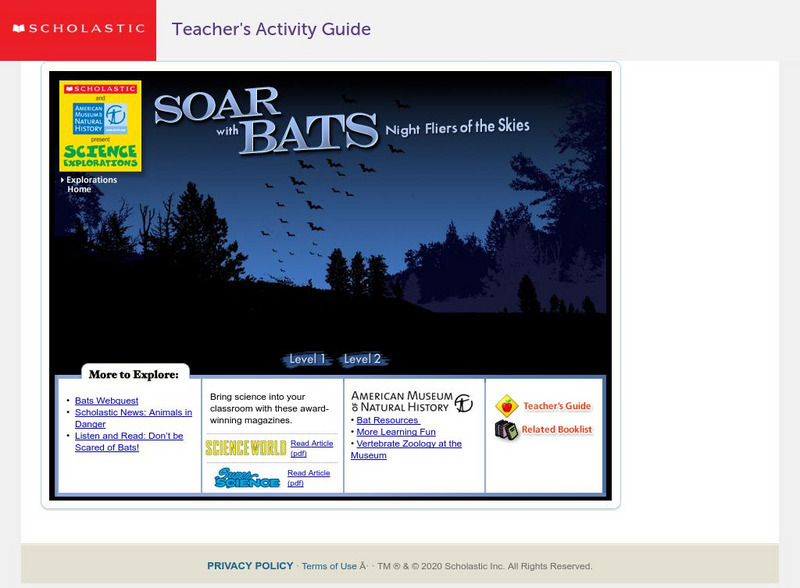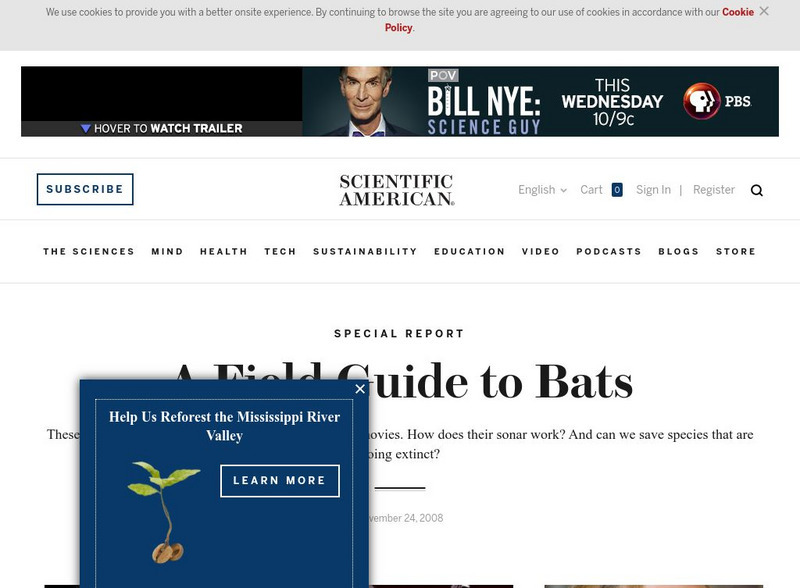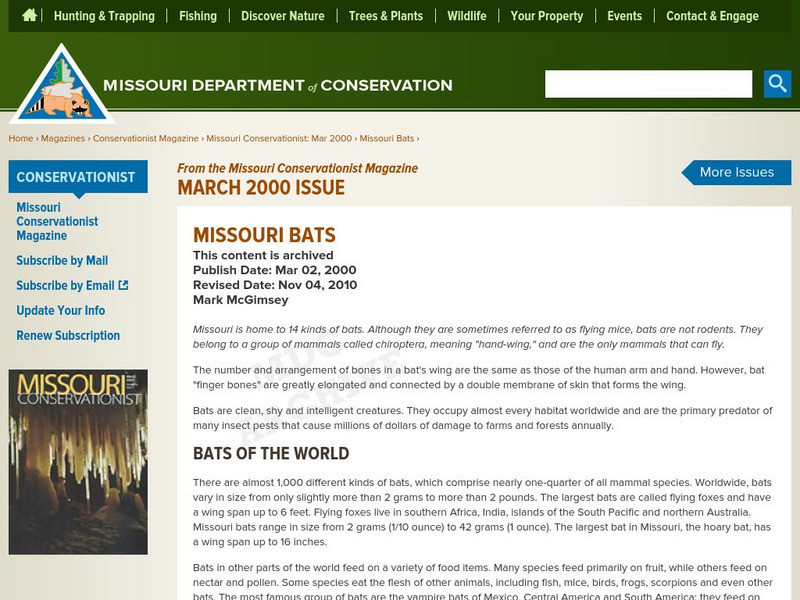NASA
Nasa: Imagers: Echo Goes to Arizona!
NASA site follows Echo the Bat as he travels through Arizona using false-color satellite images.
Scholastic
Scholastic: Science Explorations: Soar With Bats: Night Fliers of the Skies
Two levels of exploration take you on a nighttime bat investigation, offer important vocabulary and definitions, provide a library of articles, and list ideas for bat research and observations in parks and zoos.
Science Buddies
Science Buddies: Bat Detector: Listen to the Secret Sounds of Bats
Sometimes bats can "whoosh" right by you, and not be seen. In this science fair project, you will be able to detect flying bats by listening in on the ultrasonic signals they produce to locate objects in their environment. The bat...
Canadian Wildlife Federation
Hinterland Who's Who: Bats
Get the facts about bats. Canada is home to nineteen different species of bats. Besides finding detailed physical descriptions of several of these, you'll also learn about some of their unique facts and characteristics. Also included in...
Lincoln Park Zoo
Lincoln Park Zoo: Straw Colored Fruit Bat
A fact sheet about the straw-colored fruit bat. The facts include a physical description, where they can be found, what they eat, and their reproduction habits. Also included are facts about special adaptations that the fruit bat has.
Scientific American
Scientific American: A Field Guide to Bats : In Depth Reports
Uncover the evolutionary past of the mysterious bats. Find out about their amazing ability to use sonar, the threat of rabies they carry, and conservation efforts to save the species.
San Diego Zoo Global
San Diego Zoo: Bats
An in-depth description of bats, including their classification, appearance, habitat, adaptations, reproduction, diet, and other interesting facts. Also includes pictures and sound bytes. [1 min, 59 sec]
Unite for Literacy
Unite for Literacy: Mystic Aquarium: Bats Dare to Be Different
Read about bats' characteristics, habitat, diet, behavior, and their unique hearing ability called echolocation. You'll also learn why they are important to humans, the threats they face, and what you can do to help them. Includes audio...
NASA
The Story of Echo the Bat
"Follow Echo the Bat through Arizona and learn about remote sensing and use false-color satellite images to help you find Echo."
Library of Congress
Loc: Everyday Mysteries: Why Do Bats Live in Caves?
Ever wonder why bats live in caves? Or why bats don't fly into objects at night? This article describe why bats thrive in the protected shelter a cave provides. It also explains how bats use echolocation to locate food and avoid obstacles.
TED Talks
Ted: Ted Ed: I'm Batman
Amy Wray disproves the myth that bats are dangerous villains and explains why they, instead, deserve a hero's welcome- and our protection. [5:48]
PBS
Pbs Teachers:borneo: A Batty Mapping Method
Explore how bats use echolocation to find prey by using echoes to map the direction and distance to various echo sources in their surroundings. Determine the minimum distance at which an echo can be heard and the distance to an echo source.
Other
Bats4 Kids
Bats are commonly misunderstood creatures. Learn more about types of bats and their habits. Bat games, quizzes, and links can be viewed here as well.
PBS
Pbs Kids: Plum Landing: Flying Fox Bat
This PBS Kids activity is an extension of a Plum Landing episode featuring the flying fox bat. Students will learn basic information about the flying fox bat; students will also use online drawing tools to design a scene with a flying...
Defenders of Wildlife
Defenders of Wildlife: Bats
Comprehensive wildlife resource provides extensive data on the bat. Discover more about its diet, population, range, behavior and more.
Princeton University
Mammals of North America: Giant Eared Bats
From the pages of "Mammals of North America," a field guide published by Princeton University Press, this website offers general descriptions of several giant-eared bats, including the Spotted Bat, Rafinesque's Big-Eared Bat, Townsend's...
Australian Museum
Australian Museum: Bats in Australia
Curious about some of the 90 species of bats that live in Australia? Click on a region of Australia and then on the bat you would like to learn more about. Learn about their habitat, what they eat, and what threatens their survival.
BBC
Bbc Nature: Megabats
Megabats are one of the two types of bats, the others being the insect-eating bats. The megabats are fruit bats, and most species cannot echolocate. Learn more about megabats in this well-constructed overview produced by the BBC. This...
PBS
Idaho Public Education: Bats
Explore this site to understand facts and general information about bats. Learn about bat wings and houses, why they hang upside down, echolation, and more! Classroom activities and games are also included.
A-Z Animals
A Z Animals: Animal Facts: Bat (Chiroptera)
Explore images and facts about Bats, including details on their appearance, habitat, behaviour, and much more.
Other
Missouri Conservationist Online: Missouri Bats
This site provides some good overall information on bats. It provides statistical data about bats of the world, information on what bats eat, hibernation, reproductive habits, bat myths, benefits of bats, and lists some endangered bats.
Cornell Lab of Ornithology
Habitat Network: Habitat Feature: Bat Houses
Find out how providing bat houses can be beneficial to a habaitat.
Smithsonian Institution
Encyclopedia Smithsonian: Bat Facts
Information is provided regarding bats: what are they, where are they, when did they appear, how do they fly, what do they eat, can bat's swim, vampire bats, and more.






















